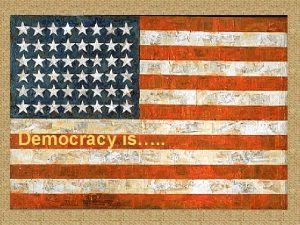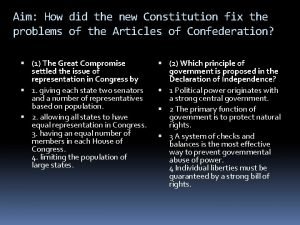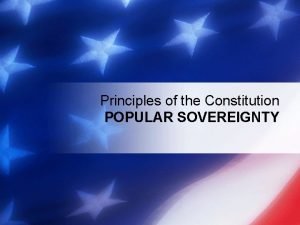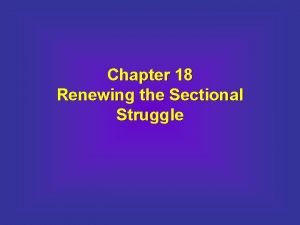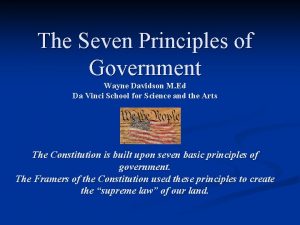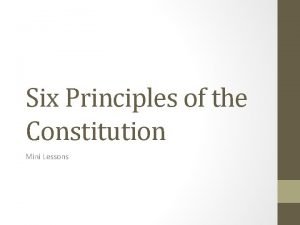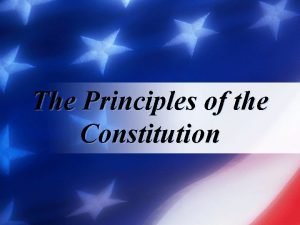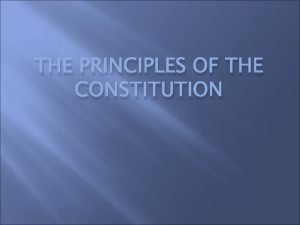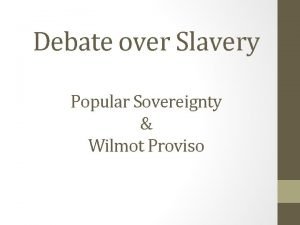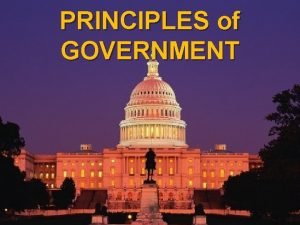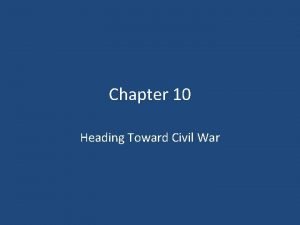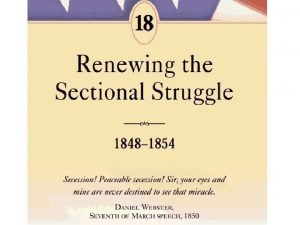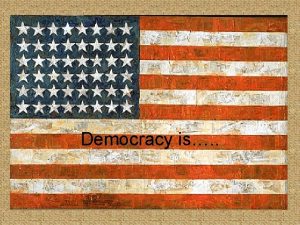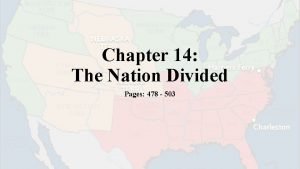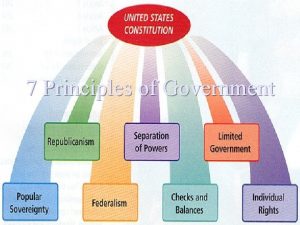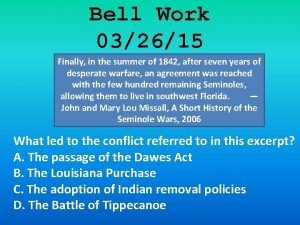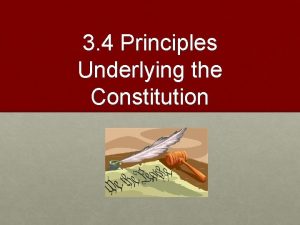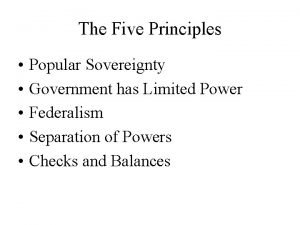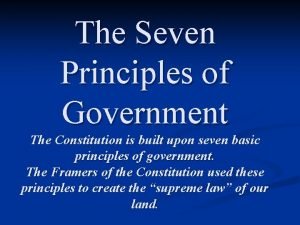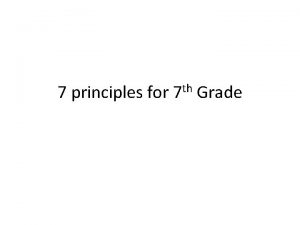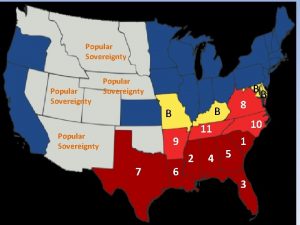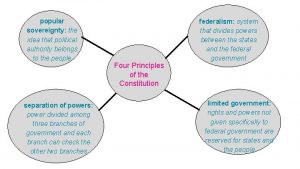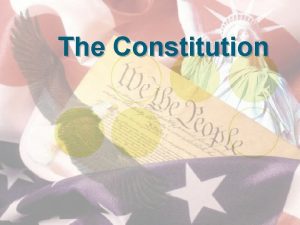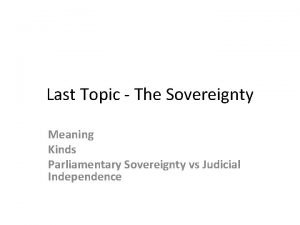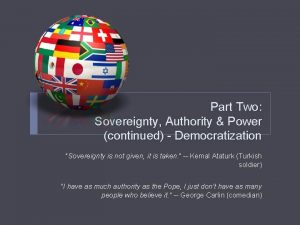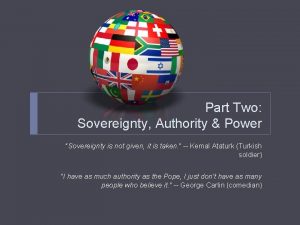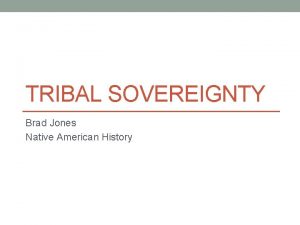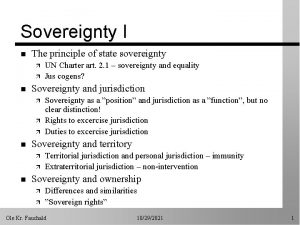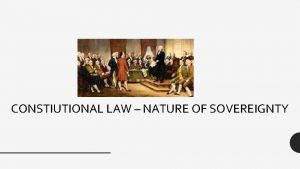Journal 22 Popular sovereignty the idea that political


























- Slides: 26

Journal #22 • Popular sovereignty – the idea that political authority belongs to the people • Federalism – the sharing of power between a central government and the states that make up a country • Checks and balances – a system to make sure no one branch of government becomes too powerful • Amendments – official changes, corrections, or additions

Bonus Questions • What was the name of the first document that set up a national government in the United States? • What problems did this government have? • What was an event that caused people to turn on this government?

The Constitution 7. 3 and 7. 4

The Constitutional Convention • By the mid-1780 s most agreed that it was time to change the Articles of Confederation • Every state except Rhode Island sent delegates to the Constitutional Convention at Independence Hall in Philadelphia in 1787 • There were 55 delegates total

Independence Hall

Who Were The 55 Delegates? • Most were well educated • Benjamin Franklin was the oldest delegate • James Madison was an important delegate because he took notes during the Convention • George Washington was a delegate and was elected president of the Convention

Who Was Not There • John Adams and Thomas Jefferson who were serving as ambassadors in other countries • Patrick Henry did not support such a meeting • Women, African Americans, and Native Americans who did not have full rights of citizens

Disagreements at the Convention • Some people wanted to make only small changes to the Articles of Confederation • Others wanted to rewrite the Articles • Small and large states had different concerns about representation • Other arguments were about slavery, tariffs, and the power of the national government

The Virginia Plan vs. The New Jersey Plan Virginia Plan • Written by James Madison • A new constitution that would give supreme power to the central government • The government is divided into the executive, judicial, and legislative branch • A two house legislature chosen on the basis of state populations • Favored by large states The New Jersey Plan • Written by William Paterson • A one-house legislature with equal representation • All acts passed by Congress shall be “the supreme law of the land” • Central government has the power to tax everyone • Government could regulate commerce • Favored by small states

The Great Compromise • 1787 • After a month of debate, the delegates were unable to agree between the Virginia and New Jersey Plans – a committee is formed • The committee proposed a compromise – In the upper house of legislature every state would have an equal vote – In the lower house of legislature, each state would have a number of representatives based upon its population – This is the reason that we have the Senate and the House of Representatives today

The Three-Fifths Compromise • Southern delegates wanted slaves to be counted as part of their state population • Most Northerners disagreed • The delegates voted to accept a compromise in which slaves are counted as 3/5 of a person to determine representation

The Foreign Slave Trade • Some delegates wanted to end the slave trade • Others threatened to leave the union if the Constitution ended the slave trade • The delegates compromised – Northerners agreed to wait 20 years before trying to end the slave trade – Southerners agreed to stop insisting that laws be passed with a 2/3 majority – “The morality of slavery is up to the states”

State and Federal Governments • Most wanted a strong national government to replace the Articles of Confederation • They also wanted to protect popular sovereignty • The delegates decide to share power between the federal and state governments federalism

Federalism • Each state must obey the Constitution • The federal government has the power to use the military to enforce its laws – these troops are under the command of the president • The states have control over government functions not specifically assigned to the federal government – Local government – Education – Civil and criminal law - courts


The Separation of Powers • The federal government has three branches 1. The legislative branch, or Congress • • Is responsible for creating and passing laws Includes the Senate and the House of Representatives 2. The executive branch • • Includes the president and those that run the government They make sure the laws are carried out 3. The judicial branch • • Made up of all the national courts Responsible for interpreting laws, punishing criminals, and settling disputes between states


Checks and Balances • The writers of the Constitution developed checks and balances to keep any branch from becoming too powerful • Examples – The president can veto, or reject, laws passed by Congress – Congress can override the veto with a 2/3 majority vote – The Supreme court can review laws passed by Congress and declare them unconstitutional


The Constitution is Finished • In September 1787, after four months of discussion, the delegates sign a final draft of the U. S. Constitution • The Constitution is then sent to the states for ratification

Federalists vs. Antifederalists • When they Constitution was made public a great debate started • Those who opposed (did not want) the Constitution were called Antifederalists – Too much power to the national government, no bill of rights – George Mason, Samuel Adams, Patrick Henry • Those who supported the Constitution were called Federalists – James Madison, George Washington, Benjamin Franklin, Alexander Hamilton, and John Jay – Thought that the Constitution had a good balance of power and that it was a good compromise between different opinions

The Federalist Papers • In the 1780 s • Widely read essays that argued in favor of the Constitution • Written under the name Publius but historians now know that they were written by Alexander Hamilton, James Madison, and John Jay • These papers strongly influenced the debate over the Constitution

The Ratification Fight • Antifederalists spoke out against the Constitution – “If you make the citizens of this country agree to become the subjects of one great consolidated empire of America, your government will not have sufficient energy to keep them together…There will be no checks, no real balances in this government. ” – Patrick Henry

The Ratification Fight • The Constitution had the support of many of the great Revolutionary heroes • Every state ratifies the Constitution by May 1790

Demanding a Bill of Rights • Several states ratified the Constitution only after they were promised that a Bill of Rights would be added to it • James Madison supported a Bill of Rights which would be added to the Constitution as amendments – Amendments needed a 2/3 majority to pass plus ratification by ¾ of the states

The Bill of Rights • Legislators stole different ideas – state ratifying conventions – the Virginia Declaration of Rights – The Declaration of Independence • The first 10 amendments to the U. S. Constitution are known as the Bill of Rights
 Direct democracy political cartoon
Direct democracy political cartoon Popular sovereignty
Popular sovereignty Popular sovereignty
Popular sovereignty The constitution spells out the powers denied to
The constitution spells out the powers denied to Popular sovereignty constitution quote
Popular sovereignty constitution quote Popular sovereignty
Popular sovereignty Popular sovereignty definiton
Popular sovereignty definiton Popular sovereignty
Popular sovereignty Popular sovereignty
Popular sovereignty Popular sovereignty
Popular sovereignty Wilmot proviso summary
Wilmot proviso summary Popular sovereignty
Popular sovereignty Whats a popular sovereignty
Whats a popular sovereignty Popular sovereignty
Popular sovereignty Popular limericks
Popular limericks Popular sovereignty
Popular sovereignty Direct democracy political cartoon
Direct democracy political cartoon 503 divided by 3
503 divided by 3 What are the 7 principles of government
What are the 7 principles of government Popular sovereignty
Popular sovereignty Popular sovereignty
Popular sovereignty Popular sovereignty
Popular sovereignty Definiton of popular sovereignty
Definiton of popular sovereignty Popular sovereignty songs
Popular sovereignty songs Popular sovereignty definition
Popular sovereignty definition What is the message
What is the message Thơ thất ngôn tứ tuyệt đường luật
Thơ thất ngôn tứ tuyệt đường luật
